|
Technology
Roots and wings
ASCnet builds on its quarter century of accomplishments
By Nancy Doucette
People with grown children will often say with some pride that they’ve provided their kids with roots and wings. The roots are the children’s foundation—their core principles and values. The wings are the courage and curiosity to
explore the unfamiliar and seek answers to life’s big questions.
As Applied Systems Client Network (ASCnet) celebrates its 25th anniversary this
year, its leadership is mindful of the organization’s roots and wings, according to ASCnet Board Chairperson Lisa Parry Becker. “It’s good to acknowledge where we’ve been, but as the board has been working this past year, we’ve been cognizant of the impact that the economy is having on our members.” Parry Becker represents the fifth generation at Wm. B. Parry & Son, Ltd., in Langhorne, Pennsylvania.
“As agents ourselves, ASCnet board members are feeling the same economic
pressures as our members are experiencing,” she continues. “So as we plan programs, we are making sure that they provide the most ‘bang for the buck’ because members are taking a careful look at where they’re spending their dollars.”
In fact, Parry Becker says, the difficult economy led the board to “examine every aspect of what we’re doing. Just like an agency needs to be operating as efficiently as possible,
so does ASCnet,” she emphasizes.
ASCnet Vice Chair Brian Bartosh, CIC, LUTCF, observes that tough times may be
the norm rather than the exception so the ASCnet board must “be prepared to lead our group with that in mind. We need to map out how we as
volunteers, and our paid staff are going to lead and make sure we’re on the right path to get things done.” Bartosh is president of Top O’ Michigan Insurance, headquartered in Alpena, Michigan. In 2011, he will chair
the user group for the third time.
“We’re a user group of Applied Systems programs, products and services,” Bartosh points out. “We do a better job for our members when we are more tightly aligned with Applied
Systems. In this current environment, it is crucial that Applied Systems and
ASCnet are in synch.”
In an effort to make that a reality, Parry Becker and Bartosh met with Applied’s senior management prior to the development of the user group’s operational plan for 2010. As a result, both organizations came away with a
clearer idea of each other’s goals for the year. “ASCnet is supporting some of Applied’s endeavors and they in turn are supporting some of ours,” Bartosh notes.
“ASCnet still maintains its separation from Applied Systems,” he emphasizes. “We’re partnering together more effectively, but we’re not giving up our independence. We’re taking advantage of each others’ resources…especially now.”
Bartosh expects the cooperation to be even tighter in 2011. That will be due in
part to the fact that ASCnet’s headquarters is moving from Florida to one of the Chicago suburbs, nearer to
Applied Systems’ headquarters.
As of press time, the search for the new location was still underway. ASCnet’s recently named CEO, Steve Johnson, a Chicago-area resident, was visiting
prospective sites. When we spoke with Johnson in late June, he had been on the
job as ASCnet CEO for a scant two weeks. While the new location had not been
finalized, Johnson said he was concentrating on office space around O’Hare International Airport, northwest of Chicago.
“The area near O’Hare would be a convenient location for ASCnet’s volunteers to travel to should they be coming in for meetings or training,” he says. “And if we need to get to Applied’s headquarters in University Park, it’s about an hour away.” ASCnet will be in its new head-quarters by the end of 2010. Everything related
to the move and changes in paid staff will be as transparent to the membership
as possible, Johnson says.
Parry Becker says the decision to move ASCnet’s headquarters wasn’t an easy one, although it had been a topic of discussion for many years. But
with the need to hire a permanent CEO, this year seemed like the right time to
discuss moving the headquarters to Chicagoland. (Rick Morgan’s “interim” CEO status was extended to provide the board with additional time to look at
the pros and cons of moving the headquarters prior to posting the CEO
position.) Parry Becker points out that the board wanted to be able to tell the
incoming CEO where the ASCnet office would be located.
Deciding to move the office to the Chicago area was based on a number of
factors, she says. “A heavy concentration of our members is in Illinois, Indiana and Ohio, in
addition to the East Coast and California.” That said, board members and volunteer leaders are scattered all over the
United States and Canada, Parry Becker explains. “When we’re looking at governance and where board meetings are held, getting to a central
location such as Chicago will make travel less expensive. Additionally, we’ll have greater access to Applied’s team when we’re at the new ASCnet location for meetings,” she says.
Another factor that weighed in Chicago’s favor was its talent pool. “Chicago is the #2 location (behind Washington, D.C.) for association
professionals,” Parry Becker notes.
The CEO Search Committee received more than 60 applications, Parry Becker
recalls. Half of the applicants were from the Chicago area. “This confirmed that, in moving the office, we would have access to good people,” she says. (More about new CEO Steve Johnson in the sidebar on page 58.)
Answers to hard questions
As Parry Becker noted earlier, the ASCnet board is examining every aspect of its
operations. They decided that a brand audit would give the group’s leadership a broad perspective on how ASCnet is perceived and what members and
the industry at large receive and expect from the association.
The board retained Aartrijk, a firm specializing in brand evaluation and
strategy, to survey ASCnet members, leadership, chapter heads, and industry
opinion leaders. “It’s crucial to have a third party conduct this brand audit,” Parry Becker asserts. “People will feel freer about expressing their opinions.” She says the findings of the audit will be the basis for many of the efforts
ASCnet undertakes—short and long term.
At the heart of the user group is its focus on users helping users, notes Patty
Andree, commercial services manager for Racine, Wisconsin-based Johnson
Insurance Services LLC, and chair of ASCnet’s Education Committee. “ASCnet was created to help users get the most out of their system,” she says. So when the Education Committee hears from ASCnet members that they
want more “back to basics” education sessions, Andree and her 25-person committee listen.
She continues: “Members are saying: ‘I bought this system a long time ago. I’m concerned that I’m not using all its capabilities. How can I get the most out of the technology
that I already have?’”
In response, more tiered sessions are being offered—basic, inter-mediate and advanced classes on specific topics. “Applied Systems personnel are facilitating the basic classes,” Andree says. “They can present information based on their knowledge of how the product was
written and what it was intended to do. The intermediate and advanced classes
are facilitated by ASCnet members who provide real-world approaches and
creative uses of the software.”
Additionally, Brian Bartosh and Doug Johnston, vice president of partner
relations and product innovation for Applied Systems, will be presenting “Developing Effective Agency Habits” as a pre-conference session at this year’s TENCon. The half-day workshop’s primary focus is to help Applied users make the most of the technology they
already have. Bartosh and Johnston have presented this session at a number of
locations around the country since January. (See “In the Loop” in the May 2010 issue of Rough Notes) for more about “Developing Effective Agency Habits.”
With all the buzz related to social media, TENCon’s opening general session will include a CEO carrier panel that will examine the
future of the insurance industry and discuss the role that social media will
play. Additionally, there will be a set of workshops designed to help agents
use the different social media tools to increase sales.
Also among the new sessions at TENCon this year are two classes designed for
agencies that are considering migrating from TAM to Epic™. A HIPAA HITECH Survival Guide will help agents make sure they’re taking the proper security precautions with customer information.
Long-time TAM users will have access to an expanding series of classes called “TAM Cleanup.” This year there are eight sessions focusing on a variety of data hotspots
including activities, field defaults, and form letters and proposals, Andree
says.
As a supporter of the industry’s Real Time/Download Campaign, ASCnet is encouraging greater adoption of real
time solutions and download initiatives, Andree explains. At TENCon, attendees
can learn how all the pieces fit together in the eight-session Pathway Series.
“TENCon is a broad spectrum event,” Andree notes. “It offers classes for everybody…management-focused sessions for owners as well as sessions for users of all
Applied’s systems and products. Although 1,100 members attend TENCon, we have
significantly more users,” she says.
That’s where other educational offerings from ASCnet come in. “We continue to review the ways that we deliver our educational content,” Andree explains. She says that Webinars have been extremely popular but some
session material doesn’t lend itself to the one-hour timeframe that is typical for a Webinar. Live boot
camp events and regional summits are offered in addition to a variety of print
materials.
Bartosh concludes: “In good economic times or challenging ones, agents need to work smarter, not
harder. Proper use of technology helps with that. ASCnet is positioned to work
smarter . . . with our staff, our new location and our new operational plan in
place.
| Evolving with the times |
The concept was a simple one: users helping users. When the user group was founded in 1985 it was known as the National User Group of Applied Systems (NUGAS).
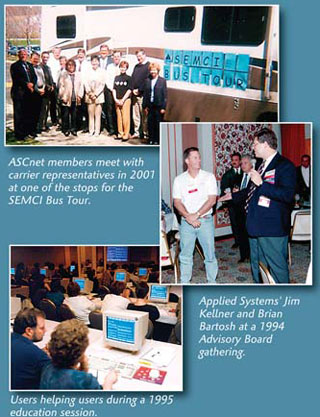 As its membership expanded into Canada, the group changed its name in 1991 to the North American Users Group of Applied Systems (NAUGAS). In that same timeframe, the group hired its first full-time executive director to help organize its 1,800 members and the user group office opened in Florida. As its membership expanded into Canada, the group changed its name in 1991 to the North American Users Group of Applied Systems (NAUGAS). In that same timeframe, the group hired its first full-time executive director to help organize its 1,800 members and the user group office opened in Florida.
By 1998, the group had some 4,100 members and it had outgrown its name again as it had attracted members in the United Kingdom, Guam, and Jamaica. So it adopted a name without a geographical reference to reflect the international makeup of the group: Applied Systems Client Network (ASCnet).
Over the last 25 years, ASCnet’s education conferences have evolved as well. The first gathering, in 1986, had 120 attendees. By 1989, the annual conference drew 350 attendees and had 14 sessions. In 2009, more than 1,100 members attended what came to be known as TENCon, ASCnet’s Technology, Education and Networking Conference. There were 150 sessions to choose from.
Since its early years, ASCnet has carried the concept of users helping users beyond its own membership. Members have held leadership positions in industry groups, become participants and leaders in ACORD and ACT working groups, as well as the standard-bearers for what used to be known as SEMCI (single-entry, multi-company interface). Not only did the group devote its time and talent to the SEMCI effort, in 1994 then-NAUGAS allocated $50,000 in development funds to help carriers implement Applied Systems’ interface solution. |
|
|
| |
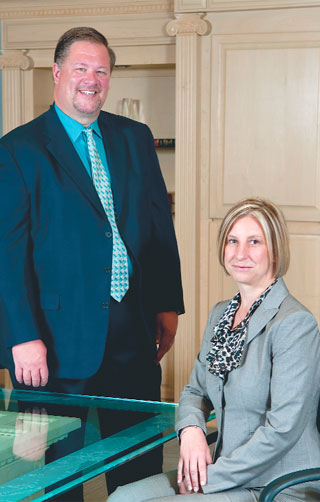 |
| |
ASCnet Vice Chair Brian Bartosh and Chair Lisa Parry Becker. |
| |
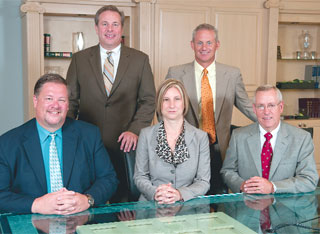 |
| |
ASCnet volunteer leaders Brian Bartosh and Lisa Parry Becker (seated, left and center, respectively) appear with the user group's new CEO Steve Johnson (seated, right) and Applied Systems executives (standing from left) Mark Layden, Chief Operating Officer; and Jim Kellner, Chairman and Chief Executive Officer. |
| |
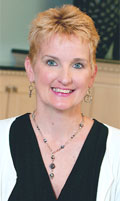 |
| |
Patty Andree, below, is Chair of the ASCnet Education Committee. |
| |
ASCnet’s new CEO |
| |
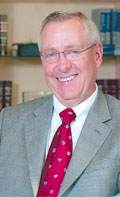 Steven D. Johnson brings 26 years of association leadership experience to his new post as CEO of ASCnet. “In my other trade association work, the members have been entrepreneurial business owners, facing many of the same challenges as independent insurance agency owners,” he notes. Steven D. Johnson brings 26 years of association leadership experience to his new post as CEO of ASCnet. “In my other trade association work, the members have been entrepreneurial business owners, facing many of the same challenges as independent insurance agency owners,” he notes.
His experience also includes guiding associations through transitions, which he says will be helpful as he organizes ASCnet’s new headquarters office in the Chicago area.
“ASCnet has a ‘member first’ focus,” Johnson says. “Those of us on the ASCnet staff need to be organized, energized and focused on bringing resolutions and solutions to members that allow them to move their businesses forward.” |
|